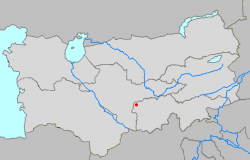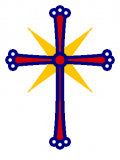School of Samarqand
| Samarqand Maktabı School of Samarqand | |
|---|---|

| |
| Data | |
| Local Language(s) | Tajik, Üzbek, Qazaq, Kırğız, Türkümän (Turkmen), Qaraqalpaq, Syriac |
| Established | 1073 (closed 1376) 1621 (reopened) |
| Location | Samarqand, Turkestan |
| Enrollment | 32,000 |
| Faculty | 1800 |
| Rector | Addaı Tomajan-ulı |
| School Colours | Dark Red and Gold |
| Map | |
 Samarqand in Turkestan | |
| Part of the series on Church of the East |

|
| Association |
| Communion of the Church of the East |
| Member Churches |
| Assyrian Church Borneian Church Religion of Light Chaldean Syrian Church Church of the East in Arakan, Burma and Tenasserim |
| Topics |
| Catholicos Assyrian Monasticism Assyrian Hospitals School of Samarqand Monastery of Mar Toma |
| People |
The School of Samarqand is the oldest extant academic institution in Central Asia, by a considerable margin (at least, according to official Turkestani sources). It was first founded in 1073 at the height of the first expansion of the Assyrian Church in Turkic Central Asia, but was closed in 1376 by the Amir Timür and not reopened again until 1621. It is still the primary Assyrian theological education centre and seminary for the region, but building on the Assyrian tradition of scholasticism, the modern School of Samarqand has expanded into one of the largest and most prestigious universities in Turkestan, and offers degrees in all the major faculties.
History
Taking its cue from the older Assyrian Schools in Edessa and Nisibis, the School of Samarqand was founded at the instigation of Catholicos Mar Abdiyeshu II (1071-1091) in 1073 in order to train the increasing numbers of bishops and higher churchmen from Central Asia without having to bring them all the way to southwestern Persia. It was one of a number of additional Schools founded at this time, but apart from the Schools of Edessa and Seleucia-Cetsiphon, it is the only one still in existence.
In Central Asia, Merv may hold the position of senior Metropolitanate, but Samarqand has the greater academic reputation.
In typical Assyrian fashion, the School was never purely a seminary. It originally had three faculties, just as the Schools of Edessa and Nisibis before them: Theology, Philosophy and Medicine. It quickly expanded into a centre of learning for the whole region; the School, the only one within several hundred çaqırım.
Timür forced the closure of the School in 1376 in order to aid the spread of his own Islamic faith, and for over two centuries there was no School of Samarqand.
In 1621, however, when the Assyrian Church in Central Asia was back on its feet and growing again, Catholicos Mar Eliya IX refounded the School of Samarqand as part of an initiative to revive the educational and scholarly traditions of the Communion of the Church of the East. The new School of Samarqand was housed in new quarters on the other side of the city, as the old School buildings had been given by Timür to the İbn Sına Islamic University.
Faculty of the School of Samarqand were heavily involved with the Turkestani Qurultaı government's literacy project, the project that developed the Soğdo script currently in use in Turkestan.
In the Ilxanate of Mızar Aman Beğ-ulı, the School of Samarqand had a student quota system forced upon them. Under this system, at least 40% of the student body had to be enrolled from non-Church of the East religious backgrounds. Similar quota systems were also instituted at other Turkestani universities, most of which were organised on religious lines: İbn Sına Islamic University, also in Samarqand, was forced to admit at least 35% non-Muslim students, and Dastur Ardaşır University in Aşğabat was made to accept at least 35% non-Zoroastrians.
Since the fall of the EBÜK regime in Turkestan, this quota system has been abandoned, but the practice of admitting students from diverse religious traditions remains.
The modern School
The modern School of Samarqand is one of the oldest and most prestigious academic institutions in all of Central Asia, if not in the world. The Assyrian seminary and theological school is still at the heart of the School, but the seminary is by no means the totality of the School. The School has first-ranking departments of theology, foreign languages, philosophy and medicine, and their faculties of natural sciences, engineering and history are also strong.
Its comparative religion and history departments in particular are widely regarded as excellent, though they are also often criticised as being too partisan towards the Church of the East. Academicians and rectors of the School of Samarqand have typically striven to point out that the School is an Assyrian institution, and this supposed "bias" is minimal, though really, an Assyrian perspective is to be expected. In fact, the alleged bias or slant in these departments is no worse than the equivalent departments in, for example, İbn Sına University.
İbn Sına University is the main traditional rival of the School of Samarqand, especially as both are centred in Samarqand, and both are considered top universities in Turkestan.
Foundation Date
The "official" date of establishment of the School of Samarqand is the subject of some controversy. The official position of the Assyrian Christian governing body of the School is that the School of Samarqand was founded in 1073. The almost 250-year hiatus after Timür closed the School in 1376 is glossed over, and the more realistic establishment date of 1621 does not count. The Turkestani government is willing to accept this piece of propaganda fiction, as it lets Turkestan lay claim to having the oldest university in Central Asia, ahead of its Persian counter-claimant.
Logo
The logo of the School of Samarqand is notable for the archaic forms of some of the letters in the name of the institution, particularly the medial /r/ and the final /d/.
Faculties
- Assyrian Seminary
- Faculty of Theology and Comparative Religion
- Faculty of Philosophy
- Faculty of Medicine
- Faculty of Natural Sciences
- Faculty of Modern Languages
- Faculty of Ancient Languages
- Faculty of the Humanities
- Faculty of Education
- Faculty of Engineering
- Faculty of the Arts
- Faculty of Economics